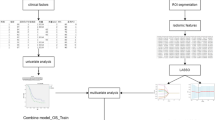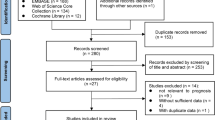Abstract
The aim of this study was to apply density correction method to the quantitative image analysis of non-small cell lung cancer (NSCLC) computed tomography (CT) images, determining its influence on overall survival (OS) prediction of surgically treated patients. Clinicopathological (CP) data and preoperative CT scans, pre- and post-contrast medium (CM) administration, of 57 surgically treated NSCLC patients, were retrospectively collected. After CT volumetric density measurement of primary gross tumour volume (GTV), aorta and tracheal air, density correction was conducted on GTV (reference values: aortic blood and tracheal air). For each resulting data set (combining CM administration and normalization), first-order statistical and textural features were extracted. CP and imaging data were correlated with patients 1-, 3- and 5-year OS, alone and combined (uni-/multivariate logistic regression and Akaike information criterion). Predictive performance was evaluated using the ROC curves and AUC values and compared among non-normalized/normalized data sets (DeLong test). The best predictive values were obtained when combining CP and imaging parameters (AUC values: 1 year 0.72; 3 years 0.82; 5 years 0.78). After normalization resulted an improvement in predicting 1-year OS for some of the grey level size zonebased features (large zone low grey level emphasis) and for the combined CP-imaging model, a worse performance for grey level co-occurrence matrix (cluster prominence and shade) and first-order statistical (range) parameters for 1- and 5-year OS, respectively. The negative performance of cluster prominence in predicting 1-year OS was the only statistically significant result (p value 0.05). Density corrections of volumetric CT data showed an opposite influence on the performance of imaging quantitative features in predicting OS of surgically treated NSCLC patients, even if no statistically significant for almost all predictors.





Similar content being viewed by others
References
Meldolesi E, van Soest J, Damiani A, Dekker A, Alitto AR, Campitelli M, Dinapoli N, Gatta R, Gambacorta MA, Lanzotti V, Lambin P, Valentini V (2016) Standardized data collection to build prediction models in oncology: a prototype for rectal cancer. Future Oncol 12(1):119–136. https://doi.org/10.2217/fon.15.295
Rami-Porta R, Asamura H, Goldstraw P (2015) Predicting the prognosis of lung cancer: the evolution of tumor, node and metastasis in the molecular age-challenges and opportunities. Transl Lung Cancer Res 4(4):415–423
Gatenby RA, Grove O, Gillies RJ (2013) Quantitative imaging in cancer evolution and ecology. Radiology 269(1):8–15. https://doi.org/10.1148/radiol.13122697
Lambin P, Leijenaar RTH, Deist TM, Peerlings J, de Jong EEC, van Timmeren J, Sanduleanu S, Larue RTHM, Even AJG, Jochems A, van Wijk Y, Woodruff H, van Soest J, Lustberg T, Roelofs E, van Elmpt W, Dekker A, Mottaghy FM, Wildberger JE, Walsh S (2017) Radiomics: the bridge between medical imaging and personalized medicine. Nat Rev Clin Oncol. https://doi.org/10.1038/nrclinonc.2017.141
Bashir U, Siddique MM, McLean E, Goh V, Cook GJ (2016) Imaging heterogeneity in lung cancer: techniques, applications, and challenges. Am J Roentgenol 207(3):534–543
Lee G, Lee HY, Park H, Schiebler ML, van Beek EJR, Ohno Y, Seo JB, Leung A (2017) Radiomics and its emerging role in lung cancer research, imaging biomarkers and clinical management: state of the art. Eur J Radiol 86:297–307. https://doi.org/10.1016/j.ejrad.2016.09.005
Gillies RJ, Kinahan PE, Hricak H (2015) Radiomics: images are more than pictures, they are data. Radiology 278(2):151169. https://doi.org/10.1148/radiol.2015151169
Larue RTHM, Defraene G, De Ruysscher D, Lambin P, Van Elmpt W (2017) Quantitative radiomics studies for tissue characterization: a review of technology and methodological procedures. Br J Radiol 90(1070):20160665
Kim SS, Seo JB, Kim N, Chae EJ, Lee YK, Oh YM, Do Lee S (2014) Improved correlation between CT emphysema quantification and pulmonary function test by density correction of volumetric CT data based on air and aortic density. Eur J Radiol 83(1):57–63. https://doi.org/10.1016/j.ejrad.2012.02.021
Stoel BC, Vrooman HA, Stolk J, Reiber JH (1999) Sources of error in lung densitometry with CT. Invest Radiol 34(4):303–309
Green FL, Page DL, Fleming ID, Fritz AG, Balch CM, Haller DG, Morrow MMM (2002) AJCC cancer staging manual, 6th edn. Springer, New York
Detterbeck FC, Boffa DJ, Tanoue LT (2009) The new lung cancer staging system. Chest 136(1):260–271. https://doi.org/10.1378/chest.08-0978
Detterbeck FC, Boffa DJ, Kim AW, Tanoue LT (2017) The eighth edition lung cancer stage classification. Chest 151(1):193–203. https://doi.org/10.1016/j.chest.2016.10.010
Dinapoli N, Alitto AR, Vallati M, Gatta R, Autorino R, Boldrini L, Damiani A, Valentini V (2015) Moddicom: a complete and easily accessible library for prognostic evaluations relying on image features. In: Proceedings on annual international conference of the IEEE Engineering in Medicine and Biology Society (EMBC) Nov 2015, pp 771–774
Zwanenburg A, Leger S, Vallieres M, Löck S. (2016) Initiative for the IBS image biomarker standardisation initiative. http://arxiv.org/abs/1612.07003. Accessed 3 May 2019
Akinci D’Antonoli T, Farchione A, Lenkowicz J, Chiappetta M, Cicchetti G, Martino A, Ottavianelli A, Manfredi R, Margaritora S, Bonomo L, Valentini V, Larici AR (2019) CT radiomics signature of tumor and peritumoral lung parenchyma to predict nonsmall cell lung cancer postsurgical recurrence risk. Acad Radiol. https://doi.org/10.1016/j.acra.2019.05.019
RStudio Team (2015) RStudio: integrated development for R. RStudio, Inc., Boston, MA. http://www.rstudio.com/. Accessed 15 Dec 2019
Davnall F, Yip CSP, Ljungqvist G, Selmi M, Ng F, Sanghera B, Ganeshan B, Miles KA, Cook GJ, Goh V (2012) Assessment of tumor heterogeneity: an emerging imaging tool for clinical practice? Insights Imaging 3(6):573–589
Alic L, Niessen WJ, Veenland JF (2014) Quantification of heterogeneity as a biomarker in tumor imaging: a systematic review. PLoS ONE 9(10):1–15
Ganeshan B, Goh V, Mandeville HC, Hoskin PJ, Miles KA (2013) Non-small cell lung cancer: histopathologic correlates for texture. Radiology 266(1):326–336
Grove O, Berglund AE, Schabath MB, Aerts HJWL, Dekker A, Wang H, Rios Velazquez E, Lambin P, Gu Y, Balagurunathan Y, Eikman E, Gatenby RA, Eschrich S, Gillies RJ (2015) Quantitative computed tomographic descriptors associate tumor shape complexity and intratumor heterogeneity with prognosis in lung adenocarcinoma. PLoS ONE 10(3):1–14. https://doi.org/10.1371/journal.pone.0118261
Ahn SY, Park CM, Park SJ, Kim HJ, Song C, Lee SM, McAdams HP, Goo JM (2015) Prognostic value of computed tomography texture features in non-small cell lung cancers treated with definitive concomitant chemoradiotherapy. Investig Radiol 50(10):719–725
Win T, Miles KA, Janes SM, Ganeshan B, Shastry M, Endozo R, Meagher M, Shortman RI, Wan S, Kayani I, Ell PJ, Groves AM (2013) Tumor heterogeneity and permeability as measured on the CT component of PET/CT predict survival in patients with non-small cell lung cancer. Clin Cancer Res 19(13):3591–3599
Ganeshan B, Panayiotou E, Burnand K, Dizdarevic S, Miles K (2012) Tumour heterogeneity in non-small cell lung carcinoma assessed by CT texture analysis: a potential marker of survival. Eur Radiol 22(4):796–802
Yang L, Yang J, Zhou X, Huang L, Zhao W, Wang T, Zhuang J, Tian J (2019) Development of a radiomics nomogram based on the 2D and 3D CT features to predict the survival of non-small cell lung cancer patients. Eur Radiol 29(5):2196–2206
Wang L, Dong T, Xin B, Xu C, Guo M, Zhang H, Feng D, Wang X, Yu J (2019) Integrative nomogram of CT imaging, clinical, and hematological features for survival prediction of patients with locally advanced non-small cell lung cancer. Eur Radiol 29(6):2958–2967
Hunter LA, Krafft S, Stingo F, Choi H, Martel MK, Kry SF, Court LE (2013) High quality machine-robust image features: identification in nonsmall cell lung cancer computed tomography images. Med Phys 40(12):121916
Fave X, Cook M, Frederick A, Zhang L, Yang J, Fried D, Stingo F, Court L (2015) Preliminary investigation into sources of uncertainty in quantitative imaging features. Comput Med Imaging Graph 44:54–61. https://doi.org/10.1016/j.compmedimag.2015.04.006
Mackin D, Fave X, Zhang L, Fried D, Yang J, Taylor B, Rodriguez-Rivera E, Dodge C, Jones AK, Court L (2015) Measuring computed tomography scanner variability of radiomics features. Investig Radiol 50(8):1–9
Yang J, Zhang L, Fave XJ, Fried DV, Stingo FC, Ng CS, Court LE (2016) Uncertainty analysis of quantitative imaging features extracted from contrast-enhanced CT in lung tumors. Comput Med Imaging Graph 48(6):1–8
Zhao B, Tan Y, Tsai W-Y, Qi J, Xie C, Lu L, Schwartz LH (2016) Reproducibility of radiomics for deciphering tumor phenotype with imaging. Sci Rep 6:23428
He L, Huang Y, Ma Z, Liang C, Liang C, Liu Z (2016) Effects of contrast-enhancement, reconstruction slice thickness and convolution kernel on the diagnostic performance of radiomics signature in solitary pulmonary nodule. Sci Rep 6(September):1–10. https://doi.org/10.1038/srep34921
Huynh E, Coroller TP, Narayan V, Agrawal V, Romano J, Franco I, Parmar C, Hou Y, Mak RH, Aerts HJWL (2017) Associations of radiomic data extracted from static and respiratory-gated CT scans with disease recurrence in lung cancer patients treated with SBRT. PLoS ONE 12(1):1–17
Lu L, Ehmke RC, Schwartz LH, Zhao B (2016) Assessing agreement between radiomic features computed for multiple CT imaging settings. PLoS ONE 11(12):1–12
Solomon J, Mileto A, Nelson RC, Roy Choudhury K, Samei E (2015) Quantitative features of liver lesions, lung nodules, and renal stones at multi-detector row CT examinations: dependency on radiation dose and reconstruction algorithm. Radiology 279(1):185–194
Kalpathy-Cramer J, Mamomov A, Zhao B, Lu L, Cherezov D, Napel S, Echegaray S, Rubin D, McNitt-Gray M, Lo P, Sieren JC, Uthoff J, Dilger SKN, Driscoll B, Yeung I, Hadjiiski L, Cha K, Balagurunathan Y, Gillies R, Goldgof D (2016) Radiomics of lung nodules: a multi-institutional study of robustness and agreement of quantitative imaging features. Tomography 2(4):430–437
Shafiq-Ul-Hassan M, Zhang GG, Latifi K, Ullah G, Hunt DC, Balagurunathan Y, Abdalah MA, Schabath MB, Goldgof DG, Mackin D, Court LE, Gillies RJ, Moros EG (2017) Intrinsic dependencies of CT radiomic features on voxel size and number of gray levels. Med Phys 44(3):1050–1062
Parmar C, Velazquez ER, Leijenaar R, Jermoumi M, Carvalho S, Mak RH, Mitra S, Shankar BU, Kikinis R, Haibe-Kains B, Lambin P, Aerts HJWL (2014) Robust radiomics feature quantification using semiautomatic volumetric segmentation. PLoS ONE 9(7):1–8
Miles KA, Ganeshan B, Hayball MP (2013) CT texture analysis using the filtration-histogram method: what do the measurements mean? Cancer Imaging 13(3):400–406
Acknowledgements
The authors thank Dr. Luca Boldrini for his advice on revision of the manuscript.
Funding
The research did not receive any specific grant from funding agencies in the public, commercial or not-for-profit sectors.
Author information
Authors and Affiliations
Corresponding author
Ethics declarations
Conflict of interest
The authors declare that they have no funding or conflict of interest regarding this study.
Ethical approval
The study is part of an institutional review board-approved protocol. All the procedures performed in this study involving human participants were in accordance with the ethical standards of the institutional and/or national research committee and with the 1964 Helsinki Declaration and its later amendments or comparable ethical standards. According to the retrospective design of the study, when provided by ethical and organizational reasons, formal consent was waived.
Additional information
Publisher's Note
Springer Nature remains neutral with regard to jurisdictional claims in published maps and institutional affiliations.
Rights and permissions
About this article
Cite this article
Farchione, A., Larici, A.R., Masciocchi, C. et al. Exploring technical issues in personalized medicine: NSCLC survival prediction by quantitative image analysis—usefulness of density correction of volumetric CT data. Radiol med 125, 625–635 (2020). https://doi.org/10.1007/s11547-020-01157-3
Received:
Accepted:
Published:
Issue Date:
DOI: https://doi.org/10.1007/s11547-020-01157-3




